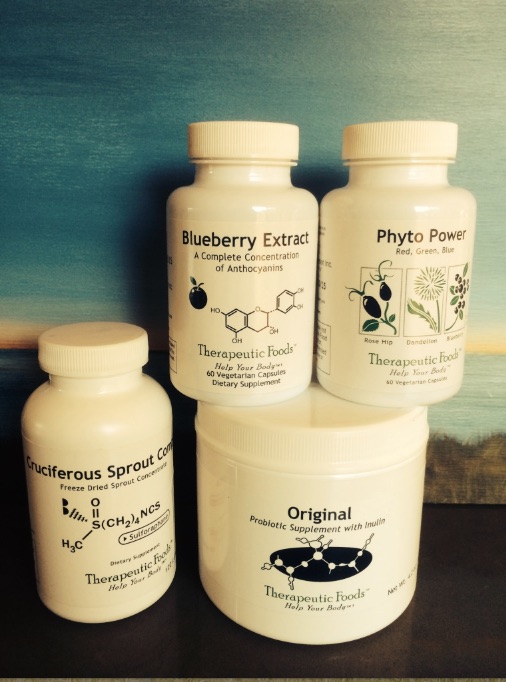Fatty Liver
Dear Friends
Nonalcoholic fatty liver disease (NAFLD), defined by excessive lipid accumulation in the liver, is the hepatic manifestation of insulin resistance and the metabolic syndrome. Due to the epidemics of obesity, NAFLD is rapidly becoming the leading cause of altered liver enzymes in Western countries (Blachier et al., 2004). A fatty liver may lead to a fatty pancreas which leads to diabetes (Lichtenstein, Schwab., 2000).
Valenti et al. (2013) explain how steatosis (fatty liver) may be associated with oxidative hepatocellular damage, inflammation, and activation of fibrogenesis, defining nonalcoholic steatohepatitis (NASH). And, NASH is potentially a progressive liver disease leading to cirrhosis and hepatocellular carcinoma.
Therapeutic Foods support for Nonalcoholic Fatty Liver Disease:

- Blueberry Extract– one daily
- Phyto Power– two daily
- Cruciferous Sprouts Complex– two daily
- Original Synbiotic– one tsp. daily
Food Science:
Anthocyanins decrease hepatic lipid accumulation and counteract oxidative stress and hepatic inflammation (Valenti, 2013; Zhu et al., 2012; Guo et al., 2011).
Blueberry Extract contains pure anthocyanin extract from Vaccinium corymbosum– a North American blueberry cultivar with an exception broad spectrum of anthocyanins. It takes us 80 pounds of blueberries to get one pound of this precious extract.
Phyto Power contains four species of wild-crafted Alaskan blueberries (the whole berry), with an exceptionally high concentration of anthocyanins. Plus, it contains the flavonoids of three species of whole wild-crafted rose hips (including seeds) and four species of wild-crafted Alaskan dandelion (including roots, leaves and flowers). The roots increase liver bile flow.
Dietary supplementation with broccoli sprout extract containing sulforaphane precursor glucoraphanin is likely to be highly effective in improving liver function through reduction of oxidative stress (Kikuchi, 2015).
Cruciferous Sprouts Complex contains broccoli sprouts, daikon radish sprouts, red radish sprouts, water cress sprouts, kale sprouts, mustard sprouts and cabbage sprouts; all together containing high levels of not only glucosinolates, but also high levels of myrosinase (from red radish), the enzymes necessary for high production of sulforaphanes.
The effects of probiotics and prebiotics have proven to be beneficial in NAFLD (Iacono, 2010; Yadav, 2007).
The Original Synbiotic contains 5 pedigreed strains of L. acidophilus, L. rhamnosus, L. plantarum, S. thermophilus and B. longum, plus inulin derived from organic chicory root.
Inulin is very bifidogenic, enhancing the growth of Lactobacillus as well. These good bacterial produce copious amounts of butyrate upon the fermentation of inulin which facilitate the tightening of gut epithelial cell junctions—reducing leaky gut syndrome. Delzenne and Kok (1999) demonstrated that FOS, modifying the gene expression of lipogenic enzymes, reduced the de novo liver fatty acid synthesis.
Lactobacillus acidophilus reduced liver oxidative stress and improved insulin resistance (Yadav et al., 2007). Lactobacillus plantarum reduced liver and serum cholesterol and triglycerides (Wang et al., 2009). Lactobacillus rhamnosus reduced hepatic steatosis (Lee 2006).
Bibliography:
- Blachier et al. (2004). The burden of liver disease in Europe: a review of available epidemiological data. Journal of Hepatology; 58(3): 593-608.
- Browning et al. (2004). Prevalence of hepatic steatosis in an urban population in the United States: impact of ethnicity. Hepatology; 40(6): 1387-1395.
- Delzenne NM, Kok NN. (1999). Biochemical basis of oligofructose3-induced hypolipidemia in animal models. J Nutr; 129: 1467S-1470S.
- Guo et al. (2011). Anthocyanin inhibits high glucose-induced hepatic mtGRAT1 activation and prevents fatty acid synthesis through PKC. Journal of Lipid Research;52(5): 908-922.
- Iacono et al. (2010). Probiotics as an emerging therapeutic strategy to treat NAFLD: focus on molecular and biochemical mechanisms. JNB; 22(8): 699-711.
- Johnson-Henry et al. (2008). Lactobacillus rhamnosus strain GG prevents enterohemorrhagic Escherichia coli 0157:H7- Induced changes in epithelial barrier function. Infect Immun; 76:1340-1348.
- Kikuchi et al. (2015). Sulforaphane-rich broccoli sprout extract improves hepatic abnormalities in male subjects. World J Gastroenterol; 21(43): 12457-12467.
- Lee et al. (2006). Human originated bacteria, Lactobacillus rhamnosus PL60, produce conjugated linoleic acid and show anti-obesity effects in diet-induced obese mice. Biochim Biophys Acta; 1761: 736-744.
- Lichtenstein AH, Schwab US. (2000). Relationship of dietary fat to glucose metabolism. Atherosclerosis; 150(2): 227-243.
- Valenti et al. (2013). Dietary Anthocyanins as Nutritional Therapy for Non alcoholic Fatty Liver Disease. Oxidative Medicine and Cellular Longevity; Volume 2013:Article ID 145421.
- Vendrame et al. (2013a). Wild Blueberry (Vaccinium angustifolium)-enriched diet improves dyslipidaemia and modulates the expression of genes related to lipid metabolism in obese Zucker rats. British Journal of Nutrition; 111(2): 194-200.
- Wang et al. (2009). Effects of Lactobacillus plantarum MA2 isolated from Tibet kefir on lipid metabolism and intestinal microflora of rats fed on high-cholesterol diet. Appl Microbiol Biotechnol; 84: 341-347.
- Yadav et al. (2007). Antidiabetic effect of probiotic dahl containing Lactobacillus acidophilus and Lactobacillus casei in high fructose fed rats. Nutrition; 23: 62-68.
- Zhu et al. (2012). The anthocyanin cyaniding-3-O-beta-glucoside, a flavonoid, increases hepatic glutathione synthesis and protects hepatocytes against reactive oxygen species during hyperglycemia: involvement of a cAMP-PKA-dependent signaling pathway. Free Radical Biology and Medicine; 52(2): 314-327.
Yours,
Seann Bardell
We have developed our products based on scientific research and/or the practical experience of many healthcare practitioners. There is a growing body of literature on food based nutrition and supplements and their application in support of our health. Please use our products under the advisement of your doctor.
Green Facts:
